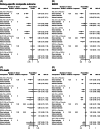Comparative efficacy of novel antidiabetic drugs on cardiovascular and renal outcomes in patients with diabetic kidney disease: A systematic review and network meta-analysis
- PMID: 35665989
- PMCID: PMC9541855
- DOI: 10.1111/dom.14702
Comparative efficacy of novel antidiabetic drugs on cardiovascular and renal outcomes in patients with diabetic kidney disease: A systematic review and network meta-analysis
Abstract
Aims: To conduct a systematic review and network meta-analysis to determine the comparative effectiveness of sodium-glucose cotransporter-2 (SGLT2) inhibitors, glucagon-like peptide-1 receptor agonists (GLP-1RAs) and dipeptidyl peptidase-4 (DPP-4) inhibitors in patients with diabetic kidney disease (DKD).
Methods: Phase III or IV randomized, placebo-controlled trials evaluating SGLT2 inhibitors, GLP-1RAs or DPP-4 inhibitors in patients with DKD were identified from the MEDLINE database. The outcomes of interest were a kidney-specific composite outcome, kidney disease progression, major adverse cardiovascular events (MACE), hospitalization for heart failure (HHF) and cardiovascular death. A network meta-analysis was conducted to calculate hazard ratios (HRs) and 95% confidence intervals (CIs).
Results: Sixteen trials representing a total of 46 292 patients were included. SGLT2 inhibitors significantly reduced the risk of the kidney-specific composite outcome by 26% compared to GLP-1RAs (HR 0.74, 95% CI 0.62-0.88) and by 36% compared to DPP-4 inhibitors (HR 0.64, 95% CI 0.52-0.79). The risk of MACE was significantly reduced with SGLT2 inhibitors (by 18%; HR 0.82, 95% CI 0.72-0.93), and with GLP-1RAs (by 18%; HR 0.82, 95% CI 0.69-0.96), compared to DPP-4 inhibitors. SGLT2 inhibitors significantly reduced the risk of HHF by 28% compared to GLP-1RAs (HR 0.72, 95% CI 0.56-0.92) and by 41% compared to DPP-4 inhibitors (HR 0.59, 95% CI 0.49-0.71).
Conclusions: A clear advantage was demonstrated by SGLT2 inhibitors in reducing the risks of CV and renal events in patients with DKD, compared to GLP-1RAs and DPP-4 inhibitors. We recommend that SGLT2 inhibitors be considered the treatment of choice in patients with DKD.
Keywords: diabetic kidney disease; dipeptidyl peptidase-4 inhibitors; glucagon-like peptide-1 receptor agonists; network meta-analysis; sodium-glucose cotransporter-2 inhibitors.
© 2022 The Authors. Diabetes, Obesity and Metabolism published by John Wiley & Sons Ltd.
Conflict of interest statement
All authors have no conflict of interest to declare.
Figures



References
-
- Saeedi P, Petersohn I, Salpea P, et al. Global and regional diabetes prevalence estimates for 2019 and projections for 2030 and 2045: results from the International Diabetes Federation Diabetes Atlas, 9th edition. Diabetes Res Clin Pract. 2019;157:107843. - PubMed
Publication types
MeSH terms
Substances
LinkOut - more resources
Full Text Sources
Medical
Miscellaneous

